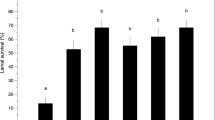Summary
This paper demonstrates the predictability and significance of changes in the temperature threshold for cold-torpor and in the threshold for survival at sub-zero temperatures in two contrasting types of climate. Both thresholds alter on a seasonal basis in both types of climate and it is observed that temperatures prevailing in autumn cause acclimatization for winter long before winter arrives.
Torpor thresholds can be accurately predicted in laboratory-simulated climates by use of a model. When the model is used for field predictions, using shade temperature data from the field, it is only successful in predicting accurate threshold values for those parts of the year during which there is a downward trend in threshold.
The relative importance of torpor-avoidance and frost-resistance is discussed with reference to records of the frequency and extent of various degrees of cold in the field. It is concluded that the marked lowering of torpor threshold prior to winter is of great significance in enabling overwintering flies to stay in their sheltered hibernacula. The relatively slight lowering of temperature threshold for frost-survival is only of significance in certain climates. It greatly improves chances of forst-survival in climates where yearly minima fall predominantly in the range-2.65°C to-4.05°C. Acclimation is not necessary for frost survival in climates where the yearly minima stay above-2.65°C whereas acclimation is ineffective in preventing frostinduced extinction when yearly minima fall below-4.5°C.
Similar content being viewed by others
References
Andrewartha, H.G., Birch, L.C.: The distribution and abundance of animals. Chicago: The University of Chicago Press 1954
Bateman, M.A.: Adaptations to temperature in geographic races of the Queensland fruit fly, Dacus (Strumeta) tryoni. Aust. J. Zool. 15, 1141–1161 (1967)
Bateman, M.A., Sonleitner, F.J.: The ecology of a natural population of the Queensland fruit fly, Dacus tryoni. I. The parameters of the pupal and adult populations during a single season. Aust. J. Zool. 15, 303–335 (1967)
Bowler, K.: A study of the factors involved in acclimatization to temperature and death at high temperatures in Astacus pallipes. I. Experiments on intact animals. J. call. comp. Physiol. 62, 119–132 (1963)
Edney, E.B.: Acclimation to temperature in terrestrial isopods. I. Lethal temperatures. Phys. Zool. 37, 364–377 (1964)
Fletcher, B.S.: The ecology of a natural population of the Queensland fruit fly, Dacus tryoni. IV. The immigration and emigration of adults. Aust. J. Zool. 21, 541–565 (1973)
Fletcher, B.S.: Temperature-regulated changes in the ovaries of overwintering females of the Queensland fruit fly, Dacus tryoni. Aust. J. Zool. 23, 91–102 (1975)
Fry, F.G.J.: Responses of vertebrate poikilotherms to temperature. In: Thermobiology (Ross, A. H., ed.), pp. 375–409. London: Academic Press 1967
McWhinnie, M.A.: The heat responses of invertebrates (exclusive of insects). In: Thermobiology (Ross, A.H., ed.), pp. 353–373. London: Academic Press 1967
Meats, A.: Rapid acclimatization to low temperature in the Queensland fruit fly, Dacus tryoni. J. Insect Physiol. 19, 1903–1911 (1973)
Meats, A.: Developmental and long-term acclimation to cold by the Queensland fruit fly (Dacus tryoni) at constant and fluctuating temperatures. J. Insect Physiol. (in press, 1976a)
Meats, A.: Thresholds for cold-torpor and cold-survival in the Queensland fruit fly (Dacus tryoni) and predictability of rates of change in survival threshold. J. Insect Physiol. (in press, 1976b)
Meats, A., Khoo, K.C.: The dynamics of ovarian maturation and oocyte resorption in the Queensland fruit fly, Dacus tryoni (Diptera), in daily-rhythmic and constant temperature regimes. Physiol. Ent. (in press, 1976)
Monro, J.: Population flushing with sexually sterile insects. Science 151, 1536–1538 (1966)
Payne, N.M.: Measures of insect cold hardiness. Biol. Bull., 52, 449–457 (1927)
Pritchard, G.: The ecology of a natural population of the Queensland fruit fly, Dacus tryoni. III. The maturation of female flies in relation to temperature. Aust. J. Zool. 18, 77–89 (1970)
Sonleitner, F.J.: Mark-recapture estimates of overwintering survival of the Queensland fruit fly, Dacus tryoni, in field cages Res. Popul. Ecol. 14, 188–208 (1973)
Author information
Authors and Affiliations
Rights and permissions
About this article
Cite this article
Meats, A. Seasonal trends in acclimatization to cold in the Queensland fruit fly (Dacus tryoni, Diptera) and their prediction by means of a physiological model fed with climatological data. Oecologia 26, 73–87 (1976). https://doi.org/10.1007/BF00345654
Received:
Issue Date:
DOI: https://doi.org/10.1007/BF00345654




